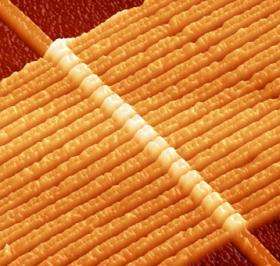April 9, 2010 report
HP Labs find memristors can compute (w/ Video)

(PhysOrg.com) -- Researchers at HP Labs, the central research arm of HP, have discovered that a resistor with memory, a “memristor” can also perform logic operations. This means chips storing data may also be able to carry out computations without the need for a central processing unit (CPU). The discovery could mean computers will be able to become more compact and efficient than imagined previously.
HP Labs first demonstrated the memristor in 2008 (see the PhysOrg article), but its theoretical existence was postulated in 1971 by Professor Leon Chua of the University of California at Berkeley. He named them memristors since they combine the electrical properties of a memory element and a resistor. They are able to retain a memory of the amount of charge that flowed through them after the power is turned off, and the resistance depends on the voltage history. According to HP Labs these tiny devices are the fourth basic building blocks of electronics, the others being resistors, capacitors and inductors.
Now a team of researchers from the HP Information and Quantum Systems Laboratory at Palo Alto, California, have created architectures for memory chips using memristors, including one in which a stack of memristors are layered in a single chip.
The team, led by the director of the laboratory, R. Stanley Williams, believe devices using the element could be developed for commercial use within a few years. These could allow supercomputers to work dramatically faster than today, and because memristors retain their memory, computers based on them could be turned off and on like a light switch.
In a news release HP Labs said memristors are faster than current storage devices such as flash memory, and they use less energy and can store more than double the data. They could also be used in handheld devices with ten times more embedded memory than today’s devices. HP Lab predicts memristor-based processors could eventually replace silicon in uses such as e-reader display screens.
Memristors are also unaffected by radiation, which can affect transistor-based technologies, and this means they could enable the development of smaller and more powerful devices, since the use of transistors is limited by Moore’s Law, which says the number of transistors that can be packed into a chip for a fixed cost has doubled every two years. Transistors on the most advanced chips have feature sizes as low as 22 nanometers, but there is a limit to how small they can become.
Williams said that as “our brains are made of memristors,” the discovery could lead to computers that work more like human brains.
The paper was published in Nature last week.
More information:
* Nature paper: www.nature.com/nature/journal/ … ull/nature08940.html
* Memristor FAQ
© 2010 PhysOrg.com















